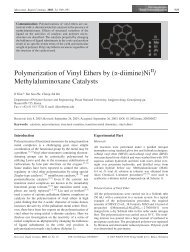Schiff-Base Complexes and their Application to Styrene ...
Schiff-Base Complexes and their Application to Styrene ...
Schiff-Base Complexes and their Application to Styrene ...
Create successful ePaper yourself
Turn your PDF publications into a flip-book with our unique Google optimized e-Paper software.
1320 I. Kim, Y. S. Ha, D. F. Zhang, C. Ha, U. LeeExperimental PartGeneral Methods <strong>and</strong> MaterialsAll reactions were performed under a purified nitrogen atmosphereusing st<strong>and</strong>ard glove-box <strong>and</strong> Schlenk techniques. <strong>Styrene</strong>(from Aldrich) was washed twice with aqueous sodiumhydroxide (5 wt.-%) <strong>and</strong> twice with water, followed by dryingover MgSO 4 <strong>and</strong> distillation over CaH 2 under N 2 atmosphereat reduced pressure. Solvents were dried under nitrogen usingst<strong>and</strong>ard reagents. MAO was obtained from Akzo Chemical asan 8.4 wt.-% <strong>to</strong>tal Al solution in <strong>to</strong>luene. The tetradentatelig<strong>and</strong> salen [1a; N,N 0 -bis(salicylidene)ethylene-1,2-diamine]<strong>and</strong> its derivatives salen(tBu) [1b; N,N 0 -bis(3-tert-butyl-2-hydroxybenzylidene)ethylene-1,2-diamine], salen(di-Me) [1c;N,N 0 -bis(2-hydroxy-3,5-dimethylbenzylidene)ethylene-1,2-diamine], salen(di-tBu) [1d; N,N 0 -bis(3,5-di-tert-butyl-2-hydroxybenzylidene)ethylene-1,2-diamine], salen(Me) [1e;N,N 0 -bis(2-hydroxy-5-methylbenzylidene)ethylene-1,2-diamine]were prepared according <strong>to</strong> a literature procedure. [15]Polymerization of <strong>Styrene</strong>A Schlenk tube (30 mL) with a magnetic stirrer was attached <strong>to</strong>a high-vacuum line <strong>and</strong> then sealed under a nitrogen atmosphere.The required amounts of distilled <strong>to</strong>luene (5 mL),styrene (5 mL), MAO <strong>and</strong> precatalyst (25.6 mmol) werecharged in<strong>to</strong> the dried Schlenk tube in this order under nitrogenflow. The polymerization was carried out at constant temperaturefor 5 h. The reaction was quenched with acidifiedmethanol (5 vol.-% HCl) <strong>and</strong> then precipitated with excessmethanol. The resulting mixture was filtered <strong>and</strong> dried undervacuum at 60 8C. The polymerization yield was determinedgravimetrically. The isolated samples comprised syndiotactic<strong>and</strong> atactic polymers, <strong>and</strong> the atactic part was extracted withrefluxing 2-butanone for 4 h. The atactic polymer was isolatedby vacuum removal of the solvent.Characterization1 H NMR spectra of salen <strong>and</strong> its derivatives were recorded on aVarian Unity Plus 300 spectrometer in CDCl 3 , using tetramethylsilaneas the internal reference. Elemental analysis wascarried out using a Vario EL analyser.The intrinsic viscosity was measured in o-dichlorobenzeneat 135 8C using a modified Ubbhelode viscometer. Theaverage molecular weight was calculated by the followingequation: [16]½ZŠ ¼1:38 10 4 M 0:7vThermal analysis of the hot 2-butanone insoluble polymerwas carried out with a differential scanning calorimeter (DSC,Perkin-Elmer DSC, model: Pyris1) at a heating rate of 10 8C/min under nitrogen atmosphere. Any thermal his<strong>to</strong>ry differencein the polymers was eliminated by first heating the specimen<strong>to</strong> above 280 8C, cooling at 10 8C/min <strong>to</strong> 90 8C, <strong>and</strong> thenrecording the second DSC scan.Syntheses of Titanium <strong>Complexes</strong>[TiCl 2 (salen)] (2a)Literature procedures were employed <strong>to</strong> synthesize titaniumsalen complexes. [17] As an example, [TiCl 2 (salen)] (2a)waspreparedas follows. H 2 salen (0.300 g, 1.12 mmol) in THF was treateddropwise with titanium(IV) chloride (0.212 g, 1.12 mmol)with vigorous stirring. Orange [TiCl 2 (salen)(THF)] precipitatedimmediately from solution. This mixture was thenrefluxed until all of the orange solid had been replaced by thedark red microcrystalline solid [TiCl 2 (salen)]. After removingthe solvent by filtration, the microcrystalline solid was washedwith an ace<strong>to</strong>ne/water mixture (50:50) <strong>and</strong> then with pureace<strong>to</strong>ne. The resulting solid was dried in vacuo. Yield: 75.6%.1 H NMR (300 MHz, CDCl 3 , 293 K): d ¼ 4.26 (s, 4 H), 6.83–7.14 (m, 4 H), 7.46–7.66 (m, 4 H), 8.38 (s, 2 H) ppm.Anal. Calcd for C 16 H 14 Cl 2 N 2 O 2 Ti: C, 49.91; H, 3.66; N,7.27. Found: C, 50.02; H, 3.71; N, 7.24.[TiCl 2 {salen(tBu)}] (2b)Following the above procedures, the crude product was recrystallizedfrom p-xylene <strong>to</strong> yield red rectangular crystalssuitable for X-ray diffraction. Yield: 87.1%.1 H NMR (300 MHz, CDCl 3 , 293 K): d ¼ 1.45 (s, 9 H), 4.15(s, 4 H), 6.93 (t, J ¼ 7.5 Hz, 2 H), 7.30 (dd, J ¼ 7.65, 1.50 Hz,2 H), 7.53 (dd, J ¼ 7.95, 1.5 Hz, 2 H), 8.72 (s, 2 H) ppm.Anal. Calcd for C 24 H 30 Cl 2 N 2 O 2 Ti: C, 57.97; H, 6.08; N,5.63. Found: C, 58.02; H, 6.07; N, 5.61.[TiCl 2 {salen(di-Me)}] (2c)Following the above procedure, the crude product was recrystallizedfrom <strong>to</strong>luene. Yield: 90.3%.1 H NMR (300 MHz, CDCl 3 , 293 K): d ¼ 2.10 (s, 6 H), 2.34(s, 6 H), 3.89 (s, 4 H), 6.43 (s, 2 H), 6.93 (s, 2 H), 7.59 (s, 2 H)ppm.Anal. Calcd for C 20 H 22 Cl 2 N 2 O 2 Ti: C, 54.45; H, 5.03; N,6.35. Found: C, 54.47; H, 5.10; N, 6.37.[TiCl 2 {salen(di-tBu)}] (2d)Following the above procedures, the crude product was recrystallizedfrom <strong>to</strong>luene <strong>to</strong> yield red rectangular crystals suitablefor X-ray diffraction. Yield: 91.5%.1 H NMR (300 MHz, CDCl 3 , 293 K): d ¼ 1.26 (s, 18 H), 1.37(s, 18 H), 4.13 (s, 4 H), 7.19 (s, 2 H), 7.53 (s, 2 H), 8.26 (s, 2 H)ppm.Anal. Calcd. for C 32 H 46 Cl 2 N 2 O 2 Ti: C, 63.06; H, 7.61; N,4.60. Found: C, 62.98; H, 7.67; N, 4.62.[TiCl 2 {salen(Me)}] (2e)Following the above procedure, the crude product was recrystallizedfrom <strong>to</strong>luene. Yield: 83.6%.1 H NMR (300 MHz, CDCl 3 , 293 K): d ¼ 2.28 (s, 6 H), 4.15(s, 4 H), 6.93 (d, J ¼ 8.4 Hz, 2 H), 7.30 (dd, J ¼ 8.4, 2.1 Hz, 2 H),8.23 (s, 2 H) ppm.Anal. Calcd for C 18 H 18 Cl 2 N 2 O 2 Ti: C, 52.33; H, 4.39; N,6.78. Found: C, 52.32; H, 4.37; N, 6.69.Macromol. Rapid Commun. 2004, 25, 1319–1323 www.mrc-journal.de ß 2004 WILEY-VCH Verlag GmbH & Co. KGaA, Weinheim





